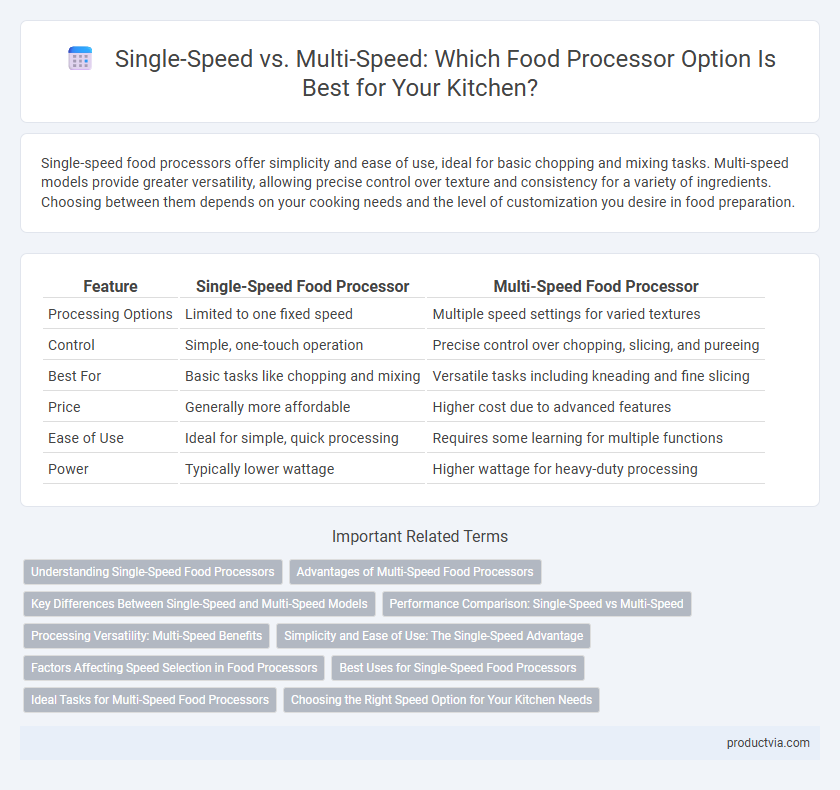Single-speed food processors offer simplicity and ease of use, ideal for basic chopping and mixing tasks. Multi-speed models provide greater versatility, allowing precise control over texture and consistency for a variety of ingredients. Choosing between them depends on your cooking needs and the level of customization you desire in food preparation.
Table of Comparison
| Feature | Single-Speed Food Processor | Multi-Speed Food Processor |
|---|---|---|
| Processing Options | Limited to one fixed speed | Multiple speed settings for varied textures |
| Control | Simple, one-touch operation | Precise control over chopping, slicing, and pureeing |
| Best For | Basic tasks like chopping and mixing | Versatile tasks including kneading and fine slicing |
| Price | Generally more affordable | Higher cost due to advanced features |
| Ease of Use | Ideal for simple, quick processing | Requires some learning for multiple functions |
| Power | Typically lower wattage | Higher wattage for heavy-duty processing |
Understanding Single-Speed Food Processors
Single-speed food processors operate at a fixed blade speed, providing consistent chopping, slicing, and mixing performance ideal for straightforward food preparation tasks. Their simplicity makes them user-friendly and easy to clean, perfect for basic processing needs without the complexity of multiple speed settings. Choosing a single-speed food processor suits those who prioritize reliability and straightforward operation over varied texture control.
Advantages of Multi-Speed Food Processors
Multi-speed food processors offer enhanced control over texture and consistency, allowing users to finely chop, puree, or knead with precision. They efficiently handle a wide range of ingredients from soft fruits to tough nuts, optimizing cooking preparation time. Variable speed settings improve versatility, making multi-speed processors ideal for complex recipes and diverse food processing needs.
Key Differences Between Single-Speed and Multi-Speed Models
Single-speed food processors operate at a fixed RPM, offering simplicity and consistent performance ideal for basic tasks like chopping and pureeing. Multi-speed models provide variable RPM settings, allowing greater control for delicate slicing, shredding, kneading, and more precise food processing techniques. The key difference lies in versatility, with multi-speed food processors adapting to diverse culinary needs, while single-speed machines emphasize straightforward, reliable functionality.
Performance Comparison: Single-Speed vs Multi-Speed
Multi-speed food processors offer precise control over texture and consistency, making them ideal for tasks requiring varied processing intensities such as chopping, pureeing, and kneading. Single-speed models provide simplicity and consistent power, suitable for straightforward tasks that do not demand variable speeds, often resulting in faster operation with less complexity. The versatility of multi-speed processors generally enhances performance across a wider range of ingredients and recipes compared to single-speed units.
Processing Versatility: Multi-Speed Benefits
Multi-speed food processors offer enhanced processing versatility, allowing precise control over texture and consistency for tasks like chopping, pureeing, and kneading. Different speed settings accommodate a variety of ingredients, from delicate herbs to tough nuts, optimizing performance and preventing over-processing. This flexibility makes multi-speed models ideal for complex recipes and diverse culinary needs compared to single-speed processors.
Simplicity and Ease of Use: The Single-Speed Advantage
Single-speed food processors excel in simplicity and ease of use with straightforward controls and minimal settings, making them ideal for everyday kitchen tasks. Their consistent, reliable power output reduces the learning curve, ensuring efficient processing without the confusion of multiple speed options. This focused functionality streamlines food preparation, especially for users seeking convenience and quick results.
Factors Affecting Speed Selection in Food Processors
Speed selection in food processors depends on the texture and consistency required for specific ingredients, where softer foods often need lower speeds and tougher items benefit from higher speeds. The motor power influences how effectively different speeds handle dense or fibrous materials, impacting processing efficiency. User control preferences and the variety of culinary tasks also guide whether single-speed or multi-speed settings are more suitable for versatile food preparation.
Best Uses for Single-Speed Food Processors
Single-speed food processors excel in tasks requiring consistent, uniform processing such as chopping vegetables, making dough, and pureeing soft ingredients. Their straightforward controls simplify operation, ideal for users prioritizing ease of use and affordability. Single-speed models deliver reliable performance for everyday kitchen jobs without the need for multiple speed adjustments.
Ideal Tasks for Multi-Speed Food Processors
Multi-speed food processors offer precise control for a variety of tasks such as chopping, slicing, shredding, and pureeing, making them ideal for recipes requiring different textures and consistencies. They excel in processing ingredients that vary in hardness, from soft fruits to tough vegetables, allowing users to adjust speeds for optimal results. This versatility enhances efficiency in meal preparation and delivers consistent culinary outcomes compared to single-speed models.
Choosing the Right Speed Option for Your Kitchen Needs
Single-speed food processors offer simplicity and consistent performance for basic chopping and mixing tasks, making them ideal for users who prefer straightforward operation. Multi-speed models provide greater versatility, allowing precise control over texture and processing intensity for diverse recipes like dough kneading, slicing, or pureeing. Selecting the right speed option depends on your kitchen needs, with multi-speed processors catering to complex culinary tasks and single-speed units suiting everyday food preparation.
Single-speed vs Multi-speed for processing options Infographic

 productvia.com
productvia.com